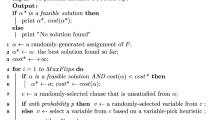Abstract
We propose a revised mixed-integer programming (MIP) method to directly compute unmarked siphons with a minimal number of places. This eliminates the need to deduce a minimal siphon from an unmarked maximal siphon obtained from the traditional MIP method proposed by Chu et al. The revised MIP test reports smaller siphons earlier than larger siphons and adds monitors to basic siphons before compound siphons. This results in adding fewer monitors and reaching more states.
Similar content being viewed by others
References
Abdallah IB, EIMaraghy HA (1998) Deadlock prevention and avoidance in FMS: a Petri net based approach. Int J Adv Manuf Technol 14(10):704–715. doi:10.1007/BF01438223
Huang YS (2007) Design of deadlock prevention supervisors for FMS using Petri nets. Int J Adv Manuf Technol 35(3–4):349–362. doi:10.1007/s00170-006-0708-y
Ezpeleta J, Colom JM, Martinez J (1995) A Petri net based deadlock prevention policy for flexible manufacturing systems. IEEE Trans Robot Autom 11:173–184. doi:10.1109/70.370500
Uzam M, Wonham WM (2006) A hybrid approach to supervisory control of discrete event systems coupling RW supervisors to Petri nets. Int J Adv Manuf Technol 28(7–8):747–760
Li ZW, Wei N (2007) Deadlock control of flexible manufacturing systems via invariant-controlled elementary siphons of Petri nets. Int J Adv Manuf Technol 33(1–2):24–35
Uzam M (2002) An optimal deadlock prevention policy for flexible manufacturing systems using Petri net models with resources and the theory of regions. Int J Adv Manuf Technol 19(3):192–208
Chu F, Xie XL (1997) Deadlock analysis of Petri nets using siphons and mathematical programming. IEEE Trans Robot Autom 13:793–804
Li ZW, Zhou MC (2006) Two-stage method for synthesizing liveness-enforcing supervisors for flexible manufacturing systems using Petri nets. IEEE Trans Indust Infor 2(4):313–325
Li ZW, Hu HS, Wang AR (2007) Design of liveness-enforcing supervisors for flexible manufacturing systems using Petri nets. IEEE Trans Sys Man Cyb C 37(4):517–526
Li ZW, Hu HS (2008) On systematic methods to remove redundant monitors from liveness-enforcing net supervisors. Comput Ind Eng. doi:10.1016/j.cie.2008.03.013
Uzam M, Li ZW, Zhou MC (2007) Identification and elimination of redundant control places in Petri net based liveness enforcing supervisors of FMS. Int J Adv Manuf Technol 35(1–2):150–168
Park J, Reveliotis SA (2001) Deadlock avoidance in sequential resource allocation systems with multiple resource acquisitions and flexible routings. IEEE Trans Automat Contr 46(10):1572–1583
Huang YS (2007) Deadlock prevention for sequence resource allocation systems. J Inf Sci Eng 23:215–231
Chao DY (2008) MIP iteration-reductions for deadlock prevention of flexible manufacturing systems. Int J Adv Manuf Technol. doi:10.1007/s00170-008-1473-x
Chao DY (2007) An incremental approach to extract minimal bad siphons. J Inf Sci Eng 23(1):203–214
Author information
Authors and Affiliations
Corresponding author
Rights and permissions
About this article
Cite this article
Chao, D.Y. Direct minimal empty siphon computation using MIP. Int J Adv Manuf Technol 45, 397–405 (2009). https://doi.org/10.1007/s00170-009-1967-1
Received:
Accepted:
Published:
Issue Date:
DOI: https://doi.org/10.1007/s00170-009-1967-1




